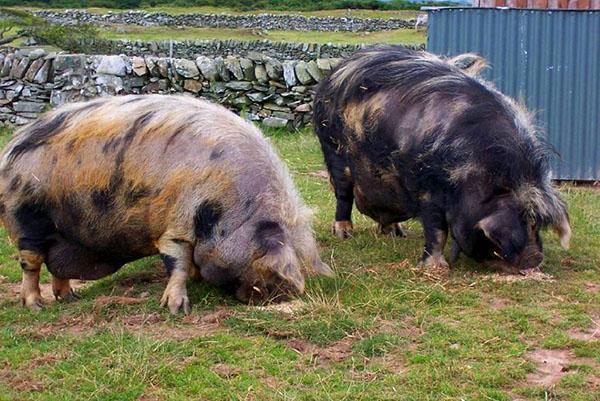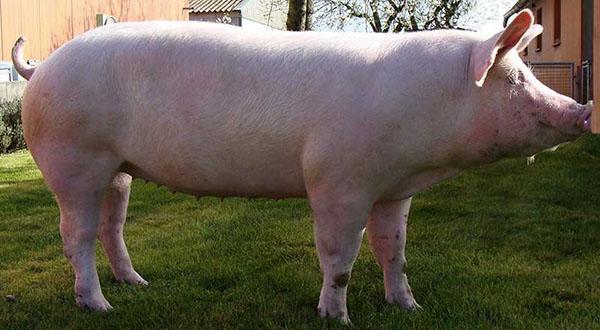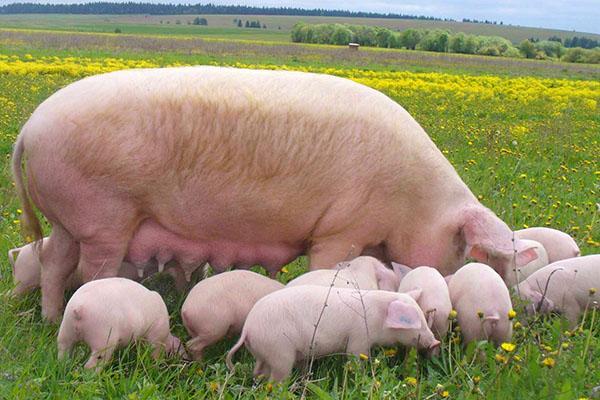Pig breeds with descriptions and photos for breeding in the courtyard
 The domestication of pigs, according to archaeologists, began 7 to 13 thousand years ago in the Middle East. Today, numerous breeds of pigs bear little resemblance to their wild ancestor, the wild boar, and thanks to breeding work, modern domestic animals are larger, more well-fed, they grow faster and gain weight.
The domestication of pigs, according to archaeologists, began 7 to 13 thousand years ago in the Middle East. Today, numerous breeds of pigs bear little resemblance to their wild ancestor, the wild boar, and thanks to breeding work, modern domestic animals are larger, more well-fed, they grow faster and gain weight.
Pigs all over the world are bred for tasty, juicy meat and high-calorie lard. Industrial applications are for leather and bristles, even bones are recycled. The breeds of such valuable farm animals are divided into several types according to their constitutional features.
Since meat and lard are the main value for livestock breeders, pig breeds are also divided according to what type of products can be obtained from animals in greater volume. The orientation of the breed necessarily affects the appearance of piglets and adults.
Representatives of the meat breed can be recognized:
- along the elongated body;
- by insignificant, when compared with the length of the body, the width of the chest;
- lightweight type of ham and sternum.
Animals intended for obtaining lard are shorter than their meat counterparts. They have a wide heavy front part, the same large, poured hams. An intermediate position between greasy and beef breeds is occupied by universal or meat-sucking varieties.
Photos and descriptions of pig breeds will help you understand the existing variety of these valuable farm animals and make the right choice when purchasing them for your own backyard. See the photo of Mularda duck!
Large white pig breed

The bred pigs were distinguished by strong bones, harmonious constitution and the ability to feed, aimed at obtaining lard, meat or juicy bacon. But the results of the work of British breeders, who gave the world the Yorkshire pig breed, were almost lost in the second half of the 19th century. Only with the introduction of strict standards and breeding rules was it possible to consolidate the breed characteristics, and the pigs were named large, white.
Animals were imported to Russia at the end of the nineteenth century. Under local conditions that are strikingly different from those of Great Britain, enthusiasts have managed to obtain well-acclimatized breeding lines. It is thanks to domestic breeders that the breed of large white pigs has been so popular both in the country and around the world for many decades.
 According to the photo and description of the breed of pigs, the characteristic features of these universal animals include:
According to the photo and description of the breed of pigs, the characteristic features of these universal animals include:
- wide convex chest;
- long wide back;
- powerful tight ass;
- strong short legs;
- thin bristles densely covering the body;
- a large head on a long thick neck;
- noticeable but not droopy ears;
- tight, but not rough skin.
 The body of an adult boar reaches a length of 190 cm, and that of a female is slightly smaller - up to 170 cm. Large white pigs are distinguished by excellent fertility.On average, a female gives birth to up to 12 piglets, which by a month reach a weight of 20-25 kg, and by six months they pull a whole centner.
The body of an adult boar reaches a length of 190 cm, and that of a female is slightly smaller - up to 170 cm. Large white pigs are distinguished by excellent fertility.On average, a female gives birth to up to 12 piglets, which by a month reach a weight of 20-25 kg, and by six months they pull a whole centner.
With good care and maintenance, animals quickly adapt to the characteristics of food and climate, they are quite hardy and fertile. However, they require nutritional control, otherwise they become excessively fat.
Pig breed Landrace
 Among modern meat breeds, the Danish variety, obtained at the beginning of the last century, is considered one of the founders of the direction. At the heart of the same pig breed Landrace - the blood of English white and local Danish animals, and to obtain good indicators for meat during the selection, not only the crossed lines were taken into account, but also the feeding methods used with the inclusion of a large amount of protein.
Among modern meat breeds, the Danish variety, obtained at the beginning of the last century, is considered one of the founders of the direction. At the heart of the same pig breed Landrace - the blood of English white and local Danish animals, and to obtain good indicators for meat during the selection, not only the crossed lines were taken into account, but also the feeding methods used with the inclusion of a large amount of protein.
The Landrace pig breed is characterized by:
- the minimum amount of fat;
- long body, inherent in meat-oriented animals;
- light rather sparse bristles;
- thin skin;
- long ears drooping to eye level.
 The body length of an adult male can exceed 180 cm, and the weight can reach up to 310 kg. Females, as expected, are smaller. With a body length of just over 165 cm, their weight is 260 kg. Landrace pigs have an average of about 11 piglets per litter. Young animals are very mobile, growing rapidly, gaining 100 kg of weight after 189 days.
The body length of an adult male can exceed 180 cm, and the weight can reach up to 310 kg. Females, as expected, are smaller. With a body length of just over 165 cm, their weight is 260 kg. Landrace pigs have an average of about 11 piglets per litter. Young animals are very mobile, growing rapidly, gaining 100 kg of weight after 189 days.
However, with all the positive qualities of this meat breed, it has disadvantages. Excellent performance and the highest quality meat can only be achieved with constant care and a well-chosen diet.
Duroc pig breed
 The American red pig breed appeared in the late 19th century. Initially, it was assumed that pigs would be raised for lard, but the growing demand for meat products has changed the direction of breeding.
The American red pig breed appeared in the late 19th century. Initially, it was assumed that pigs would be raised for lard, but the growing demand for meat products has changed the direction of breeding.
Today, the main characteristics of Duroc pigs are:
- excellent quality meat;
- early maturity;
- endurance and the possibility of keeping in pasture conditions;
- the ability to pass on their best traits to descendants, therefore, Duroc pigs are actively used for hybridization.
Animals have a strong skeleton and a powerful physique, which must be maintained with properly selected protein feed. Both boars and adult females do not exceed 185 cm in length.
 Unlike fertile white pigs and animals belonging to the Landrace breed, the broods of Duroc females are no more than 11 piglets, while the sows are calm, caring and perfectly take care of the rapidly growing generation, already after 170-180 days weighing more than 100 kg.
Unlike fertile white pigs and animals belonging to the Landrace breed, the broods of Duroc females are no more than 11 piglets, while the sows are calm, caring and perfectly take care of the rapidly growing generation, already after 170-180 days weighing more than 100 kg.
Mangal pigs
 There have been several breeds of woolly animals in the history of pig production. In the second half of the 19th century, animals from the county of Lincolnshire were considered one of the best along with the Yorkshire pig breed. The thick hair of these pigs resembled sheep's wool and was even used to make coarse home yarn. But in 1972, it was officially recognized that the Lincolnshire pigs were lost.
There have been several breeds of woolly animals in the history of pig production. In the second half of the 19th century, animals from the county of Lincolnshire were considered one of the best along with the Yorkshire pig breed. The thick hair of these pigs resembled sheep's wool and was even used to make coarse home yarn. But in 1972, it was officially recognized that the Lincolnshire pigs were lost.
 Fortunately, a variety of Hungarian or Carpathian woolly pigs, which is close to the extinct breed, has survived - Mangalitsa or Mangalitskaya woolly. Animals can be of different colors, they are picky, thanks to their thick wool, they are hardy and give meat of excellent quality.
Fortunately, a variety of Hungarian or Carpathian woolly pigs, which is close to the extinct breed, has survived - Mangalitsa or Mangalitskaya woolly. Animals can be of different colors, they are picky, thanks to their thick wool, they are hardy and give meat of excellent quality.
Pigs of the Mangal breed are extremely picky, have strong immunity, which makes it possible to refuse to vaccinate young animals and use a variety of types of feed.
The only drawback is the relative rarity of meat pigs and the small number of piglets in litters. On average, the female gives only 4–5 offspring; in the future, the number of babies in the brood slightly increases.
Asian pot-bellied pigs
 Acquaintance with Asian pot-bellied pigs among European livestock breeders began only at the end of the last century. The stocky animals with a powerful body and large head, known as Vietnamese, Chinese or Korean pigs, caused a real flurry of admiration and surprise.
Acquaintance with Asian pot-bellied pigs among European livestock breeders began only at the end of the last century. The stocky animals with a powerful body and large head, known as Vietnamese, Chinese or Korean pigs, caused a real flurry of admiration and surprise.
Small, in comparison with traditional breeds of pigs, animals are early maturing, give excellent meat, cleanliness and rather unpretentious.
 With an average weight of an adult boar of 150 kg and a female - about 120 kg, the yield of juicy low-fat meat can exceed 75%, which is a kind of record among meat breeds. At the same time, females are ready to give their first offspring as early as 4 months, and the number of piglets during farrowing sometimes reaches 20 heads. Picky animals feed on grain, hay and green fodder, do not need vaccinations and special conditions.
With an average weight of an adult boar of 150 kg and a female - about 120 kg, the yield of juicy low-fat meat can exceed 75%, which is a kind of record among meat breeds. At the same time, females are ready to give their first offspring as early as 4 months, and the number of piglets during farrowing sometimes reaches 20 heads. Picky animals feed on grain, hay and green fodder, do not need vaccinations and special conditions.
If the piglets are properly cared for, they reach slaughter weight by 7 months, not lagging behind the Duroc or Large Whites in growth rates.
Vietnamese or Asian pot-bellied pigs, recently appearing on European farms, immediately aroused the interest of breeders.
 At the moment, dwarf pigs have been obtained on the basis of these animals and small European boars. Miniature animals are becoming more and more popular around the world. Photos and descriptions of the pig breed touch and surprise even people far from animal husbandry, and mini-pigs are bred all over the world as decorative pets.
At the moment, dwarf pigs have been obtained on the basis of these animals and small European boars. Miniature animals are becoming more and more popular around the world. Photos and descriptions of the pig breed touch and surprise even people far from animal husbandry, and mini-pigs are bred all over the world as decorative pets.
Pig breed Karmal
A hybrid obtained from a complex crossing of a pot-bellied pig and a woolly mangalica was named Karmal. The animals received a record early maturity of Asian ancestors, but much heavier and larger. An adult pig of the Karmal breed can gain weight of about 200 kg, while giving preference to cheap vegetable feed and not showing whims in keeping.
 From the Carpathian pig, hybrid animals inherited a rather thick coat and children's striped piglets. Pigs do not need insulated rooms even for the winter, and strong stomachs allow them to digest even roughage, inaccessible to the ancestors of the Vietnamese breed. With such a mass of positive qualities, this variety cannot yet be called fully formed. Breeding work on the Karmal pig breed is being actively carried out in order to consolidate and increase the best traits.
From the Carpathian pig, hybrid animals inherited a rather thick coat and children's striped piglets. Pigs do not need insulated rooms even for the winter, and strong stomachs allow them to digest even roughage, inaccessible to the ancestors of the Vietnamese breed. With such a mass of positive qualities, this variety cannot yet be called fully formed. Breeding work on the Karmal pig breed is being actively carried out in order to consolidate and increase the best traits.